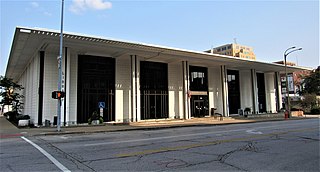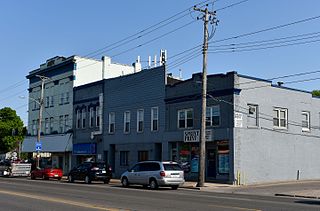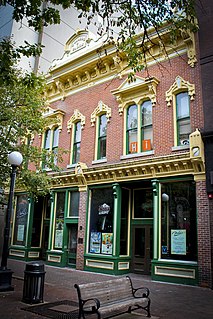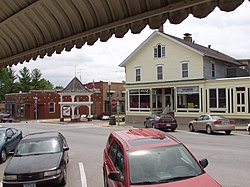
The Herbert Hoover National Historic Site is a unit of the National Park System in West Branch, Iowa, United States. The buildings and grounds are managed by the National Park Service to commemorate the life of Herbert Hoover, the 31st President of the United States. The park was established in 1965, shortly after it was named a National Historic Landmark. It now encompasses 186.8 acres (75.6 ha).

West Branch is a city in Cedar and Johnson counties in the U.S. state of Iowa. The population was 2,322 as of 2010 the 2010 census. It is the birthplace of the only American president born in Iowa, Herbert Hoover.

The Main Street Historic District encompasses the historic commercial center of Middletown, Connecticut, United States. Middletown was one of the most important ports on the Connecticut River during the colonial period, and Main Street "has been the center of community life since the earliest period of settlement". Today Main Street is home to a number of 19th century buildings, maintaining the bulk of its historic character. It was listed on the National Register of Historic Places in 1983.

Feraud General Merchandise Store, also known as 1903 Building, was built in 1903 in Ventura, California. Jules Feraud opened the Feraud Bakery and Grocery Store and the bakery stayed in the family until 1944. The brick building is a rare intact example of turn-of-the-century commercial architecture during Second Land Boom after the tracks of the Southern Pacific Railroad arrived in Ventura. The City Council of Ventura designated the building Historic Landmark Number 35 by resolution on July 17, 1978. The building was listed on the National Register of Historic Places in 1986.
Preservation Iowa, formerly called the Iowa Historic Preservation Alliance (IHPA), was founded in 1989 by members of the public concerned about the destruction of significant historic sites and buildings in the state of Iowa.

The Gruwell and Crew General Store is one of the oldest buildings in West Branch, Iowa. Mayor S.C. Gruwell and J.C. Crew built the structure in 1894, it operated as a music store, harness shop, shoe repair shop, and as a variety store. In 1964 the West Branch Heritage Foundation converted it to a museum. The building has its original false-front facade and wooden ceiling, floor and walls. It is part of the West Branch Commercial Historic District.

The Masonic Building, also called the Burrows Block, Bank Block, and Masonic Temple stands on the public square in Osceola, Iowa, United States. It was constructed by banker A.H. Burrows in 1872. The upper stories of this Italianate building were used by Osceola Lodge No. 77 of the Ancient Free & Accepted Masons, and the main floor was a bank and hardware store. This building has been placed on Preservation Iowa’s Most Endangered list because of its poor repair and lack of preservation plan. It was individually listed on the National Register of Historic Places in 2010. In 2018 it was included as a contributing property in the Osceola Commercial Historic District.

The Davenport Public Library is a public library located in Davenport, Iowa. With a history dating back to 1839, the Davenport Public Library's Main Library is currently housed in a 1960s building designed by Kennedy Center architect Edward Durell Stone. The Davenport Public Library system is made up of three libraries—the Main Library at 321 Main Street; the Fairmount Branch Library at 3000 N. Fairmount Street; and the Eastern Avenue Branch Library at 6000 Eastern Avenue.

Davenport Bank and Trust Company was for much of the 20th century the leading bank of the Quad Cities metropolitan area and the surrounding region of eastern Iowa and western Illinois. It was at one time Iowa's largest commercial bank, and the headquarters building has dominated the city's skyline since it was constructed in 1927 at the corner of Third and Main Streets in downtown Davenport, Iowa. It was acquired by Norwest Bank of Minneapolis in 1993 and now operates as part of Wells Fargo following a 1998 merger of the two financial institutions. The historic building was listed on the National Register of Historic Places in 1983 under the name of its predecessor financial institution American Commercial and Savings Bank. In 2016 the National Register approved a boundary increase with the Davenport Bank and Trust name. It was included as a contributing property in the Davenport Downtown Commercial Historic District in 2020. It remains the tallest building in the Quad Cities, and is today known as Davenport Bank Apartments as it has been redeveloped into a mixed-use facility housing commercial, office and residential space.

The Hibernia Hall, also known as the Hibernian Hall, is a Romanesque Revival building located in downtown Davenport, Iowa, United States. It is located on the east side of Brady Street, near the middle of the block. The Hibernian Hall was individually listed on the National Register of Historic Places in 1983.In 2020 it was included as contributing property in the Davenport Downtown Commercial Historic District.

The Henry Berg Building is a historic building located in downtown Davenport, Iowa, United States. It has been individually listed on the National Register of Historic Places since 1983. In 2020 it was included as a contributing property in the Davenport Downtown Commercial Historic District.

The Sundberg Block was a commercial building located at 517–523 Iron Street in Negaunee, Michigan, United States. It was listed on the National Register of Historic Places in 2011. It was later demolished in November 2016 and removed from the NRHP in 2020.

The College Corner Commercial Historic Business District, also known as the Highland Park Historic Business District at Euclid and Second, is located in the north-central section of Des Moines, Iowa, United States. It is located in the Highland Park neighborhood that also includes the Highland Park Historic Business District at Euclid and Sixth Avenues. The College Corner historic district has been listed on the National Register of Historic Places since 1998.

Edward Hammatt was an architect in the United States. He designed several notable buildings that are listed on the National Register of Historic Places.

The Joseph "Diamond Jo" Reynolds Office Building and House is a historic building located in McGregor, Iowa, United States. Joseph "Diamond Joe" Reynolds was a New York native who started working in a gristmill in the 1840s. As the grain belt moved to the west, he moved with it, settling in Chicago in the 1850s and McGregor around 1860. Because of difficulties accessing steamboats to ship grain down the Mississippi River, he established the Diamond Jo line in 1866. It grew to become a major player in the transportation industry. He had its headquarters moved from Fulton, Illinois to Dubuque, Iowa in 1874. By the late 1870s railroads had taken over as the primary means of shipping grain, and Reynolds turned his attention to passenger boats. He had this combination office and residential building constructed in 1885. Reynolds died in 1891 and his widow sold the building before her death in 1895. It has subsequently housed grain trader offices, a billiard parlor, the post office, a winery, shops, and apartments.

The Sentinel Block is a historic building located in Iowa Falls, Iowa, United States. Previous commercial blocks in Iowa Falls tended to follow the more ornate Italianate style. This building, completed in 1905, marks a departure from those older structures. Rectilinear brick panels above the windows replaced the decorative hoodmolds, and the brick patterned cornice with a plain stone cap replaced the heavy metal cornice. The building also features an oriel window with a crenelated parapet. The building housed the Iowa Falls Sentinel for over 20 years. It began as the Eldora Sentinel in 1857, relocated to Iowa Falls in 1865, and was bought out by its competitor, the Hardin County Citizen, in 1927.

The Upper Iowa Street Historic District is a nationally recognized historic district located in Dubuque, Iowa, United States. It was listed on the National Register of Historic Places in 2015. At the time of its nomination it consisted of nine resources, which included eight contributing buildings and one non-contributing building. The district is a single block with commercial and residential buildings on both sides of Iowa Street. It was originally a residential section on the north side of the central business district. The first two commercial buildings were substantial Italianate-style structures constructed on the north side of the block in the mid-1880s. In the 1890s larger and more elaborate Queen Anne commercial buildings were built to the south. The oldest building is an 1872 residence that was used as a doctor's office and other business purposes. It has subsequently been covered in Permastone. The rest of the buildings are brick with stone ornamentation.

The College Block Building is a historic building located in Iowa City, Iowa, United States. Completed in 1883, this is the first known architect-designed commercial building in Iowa City. It was designed by local architect Chauncey F. Lovelace, who moved his office into the building. The main facade of this two-story brick structure is capped with an ornate, bracketed, tin cornice with the words "College Block" on an ornamented crest. There are eight windows on the second floor, all with ornate windowhoods. The second and third windows on both ends are coupled together under a larger hood. The main floor is occupied by commercial space, and the second floor contains apartments. Urban renewal threatened the building's existence in the 1970s. It was listed on the National Register of Historic Places in 1973.

The Mount Vernon Commercial Historic District is a nationally recognized historic district located in Mount Vernon, Iowa, United States. It was listed on the National Register of Historic Places in 1993. At the time of its nomination it consisted of 18 resources, which included 16 contributing buildings and two non-contributing buildings. This linear historic district is a block and a half in the middle of the central business district. It follows the ridgeline of the paha that defines the town. The buildings were constructed between 1860 and the 1930s, with most of them in place by the turn of the 20th century. Eight of them were built in the 1890s. The district is also unified in appearance with two-story pressed brick facades, ornate metal cornices, heavy pedimented window hoods, and roughly dressed limestone trim dominate. The decorative elements recall Mount Vernon's railroad-related prosperity, as they were brought in by train.

The Davenport Downtown Commercial Historic District is a nationally recognized historic district located in the central business district of Davenport, Iowa, United States. It was listed on the National Register of Historic Places in 2020. At the time of its nomination it consisted of 43 resources, which included 33 contributing buildings, one contributing structure, and nine non-contributing buildings. In addition, the district also contains 33 buildings that are individually listed on the National Register. This historic district is bordered by four other districts: the Crescent Warehouse Historic District and the Davenport Motor Row and Industrial Historic District on the east, the Hamburg Historic District to the northwest, and the West Third Street Historic District on the west.
























